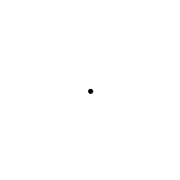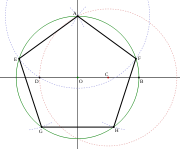Pentagon
From Wikipedia, the free encyclopedia
| This article needs additional citations for verification. Please help improve this article by adding reliable references. Unsourced material may be challenged and removed. (July 2008) |
| Regular pentagon | |
|---|---|
 A regular pentagon, {5} |
|
| Edges and vertices | 5 |
| Schläfli symbol | {5} |
| Coxeter–Dynkin diagram | |
| Symmetry group | Dihedral (D5) |
| Area (with t=edge length) |
  |
| Internal angle (degrees) |
108° |
| Properties | convex, cyclic, equilateral, isogonal, isotoxal |
| Look up pentagon in Wiktionary, the free dictionary. |
In geometry, a pentagon is any five-sided polygon. A pentagon may be simple or self-intersecting. The internal angles in a simple pentagon total 540°. A pentagram is an example of a self-intersecting pentagon.
Contents |
[edit] Regular pentagons
The term pentagonal is commonly used to mean a regular convex pentagon, where all sides are equal and all interior angles are equal (to 108°). Its Schläfli symbol is {5}. The chords of this pentagon are in golden ratio to its sides.
The area of a regular convex pentagon with side length t is given by
A pentagram or pentangle is a regular star pentagon. Its Schläfli symbol is {5/2}. Its sides form the diagonals of a regular convex pentagon - in this arrangement the sides of the two pentagons are in the golden ratio.
When a regular pentagon is inscribed in a circle with radius R, its edge length t is given by the expression
[edit] Derivation of the Area formula
The area of any regular polygon is:
where P is the perimeter of the polygon, and a is the apothem. We can then substitute the respective values for P and a, which makes the formula:
with t as the given side length. Then we can then rearrange the formula as:
and then, we combine the two terms to get the final formula, which is:
 .
.
[edit] Derivation of the Diagonal Length formula
The diagonals of a regular pentagon (hereby represented by D) can be calculated using the following formula:
where T = the side length of the pentagon, itself.
[edit] Construction
A regular pentagon is constructible using a compass and straightedge, either by inscribing one in a given circle or constructing one on a given edge. This process was described by Euclid in his Elements circa 300 BC.
One method to construct a regular pentagon in a given circle is as follows:
An alternative method is this:
- Draw a circle in which to inscribe the pentagon and mark the center point O. (This is the green circle in the diagram to the right).
- Choose a point A on the circle that will serve as one vertex of the pentagon. Draw a line through O and A.
- Construct a line perpendicular to the line OA passing through O. Mark its intersection with one side of the circle as the point B.
- Construct the point C as the midpoint of O and B.
- Draw a circle centered at C through the point A. Mark its intersection with the line OB (inside the original circle) as the point D.
- Draw a circle centered at A through the point D. Mark its intersections with the original (green) circle as the points E and F.
- Draw a circle centered at E through the point A. Mark its other intersection with the original circle as the point G.
- Draw a circle centered at F through the point A. Mark its other intersection with the original circle as the point H.
- Construct the regular pentagon AEGHF.
A direct method using degrees follows:
- Draw a circle and choose a point to be the pentagon's (e.g. top center)
- Draw a guideline through it and the circle's center
- Draw lines @ 54 degrees (from the guideline) intersecting the pentagon's point
- Where those intersect the circle, draw lines @ 18 degrees (from parallels to the guideline)
- Join where they intersect the circle
After forming a regular convex pentagon, if you join the non-adjacent corners (drawing the diagonals of the pentagon), you obtain a pentagram, with a smaller regular pentagon in the center. Or if you extend the sides until the non-adjacent ones meet, you obtain a larger pentagram.
A simple method of creating a regular pentagon from just a strip of paper is by tying an overhand knot into the strip and carefully flattening the knot by pulling the ends of the paper strip. Folding one of the ends back over the pentagon will reveal a pentagram when backlit.
[edit] Pentagons in nature
[edit] Plants
|
Pentagonal cross-section of okra. |
Morning glories, like many other flowers, have a pentagonal shape. |
The gynoecium of an apple contains five carpels, arranged in a five-pointed star |
Starfruit is another fruit with fivefold symmetry. |
[edit] Animals
|
A sea star. Many echinoderms have fivefold radial symmetry. |
An illustration of brittle stars, also echinoderms with a pentagonal shape. |
[edit] See also
- The Pentagon, headquarters for the U.S. Department of Defense
- Dodecahedron, a polyhedron whose regular form is composed of 12 pentagonal faces
- Trigonometric constants for a pentagon
- Pentagonal numbers
- Associahedron - A pentagon is an order-4 associahedron
- Pentagram
- Pentastar, the Chrysler logo
[edit] External links
- Weisstein, Eric W., "Pentagon" from MathWorld.
- How to construct a regular pentagon with only a only compass and straightedge.
- How to fold a regular pentagon using only a strip of paper
- Definition and properties of the pentagon, with interactive animation
- Nine constructions for the regular pentagon by Robin Hu
- Renaissance artists' approximate constructions of regular pentagons at Convergence
- Pentagon. How to calculate various dimensions of regular pentagons.
|
||||||||||||||













